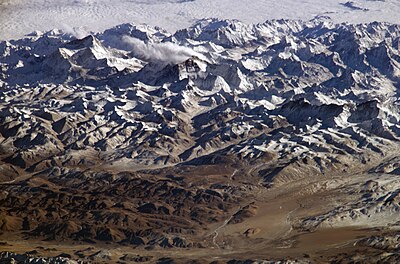| Revision as of 08:18, 23 April 2004 editFredrik (talk | contribs)23,349 edits image← Previous edit | Revision as of 12:32, 23 April 2004 edit undoLumos3 (talk | contribs)Autopatrolled, Extended confirmed users29,319 edits List of major peaks addedNext edit → | ||
| Line 15: | Line 15: | ||
| According to ], the Himalayas are the result of a ] between the ] and ] ]. The continued movement of these plates means the Himalayas are still growing in size. ] believe that the Himalayas would rise at the rate of about 8 to 10 centimeters per year if plate tectonics were the only factor. There are also, however, forces of ] which are wearing the mountains down. The approximate net growth of the Himalayas amounts to 2.5 to 5 centimeters per century. | According to ], the Himalayas are the result of a ] between the ] and ] ]. The continued movement of these plates means the Himalayas are still growing in size. ] believe that the Himalayas would rise at the rate of about 8 to 10 centimeters per year if plate tectonics were the only factor. There are also, however, forces of ] which are wearing the mountains down. The approximate net growth of the Himalayas amounts to 2.5 to 5 centimeters per century. | ||
| ==Individual peaks== | |||
| ''See also:'' ], ], ] | |||
| * ] 8,850 m | |||
| * ] 8,611 m | |||
| * ] 8,586 m | |||
| * ] 8,501 m | |||
| * ] 8,462 m | |||
| * ] 8,201 m | |||
| * ] 8,167 m | |||
| * ] 8,163 m | |||
| * ] 8,126 m | |||
| * ] 8,091 m | |||
| * ] 8,068 m | |||
| * ] 8,047 m | |||
| * ] 8,035 m | |||
| * ] 8,027 m | |||
| * ] a popular climbing peak of 7,161 metres. | |||
| ==See also== | |||
| * ] - a list of Himalayan peaks over 8000 meters | |||
| * ], | |||
| ==External Link== | ==External Link== | ||
Revision as of 12:32, 23 April 2004

The Himalayas (the Himalayan Range) are a mountain range in Asia, separating India and Pakistan on the south and southwest from the vast Tibetan plateau (occupied by China) on the north. Nepal and Bhutan are sovereign nations in the southern foothills. The Himalayas connect with the Hindu Kush mountain range in Afghanistan. The word Himalaya is of Sanskrit origin and means abode of snow.
Many of the world's highest mountains, such as Mount Everest (8850 m), K2 (8611 m) and Kanchenjunga (8598 m) are situated in the Himalayas.
According to plate tectonics, the Himalayas are the result of a convergent boundary between the Indo-Australian and Eurasian Plates. The continued movement of these plates means the Himalayas are still growing in size. Geologists believe that the Himalayas would rise at the rate of about 8 to 10 centimeters per year if plate tectonics were the only factor. There are also, however, forces of erosion which are wearing the mountains down. The approximate net growth of the Himalayas amounts to 2.5 to 5 centimeters per century.
Individual peaks
- Mount Everest 8,850 m
- K2 8,611 m
- Kangchenjunga 8,586 m
- Lhotse 8,501 m
- Makalu 8,462 m
- Cho Oyu 8,201 m
- Dhaulagiri 8,167 m
- Manaslu 8,163 m
- Nanga Parbat 8,126 m
- Annapurna 8,091 m
- Gasherbrum I 8,068 m
- Broad Peak 8,047 m
- Gasherbrum II 8,035 m
- Shishapangma 8,027 m
- Pumori a popular climbing peak of 7,161 metres.
See also
- Eight-thousander - a list of Himalayan peaks over 8000 meters
- Geography of China,